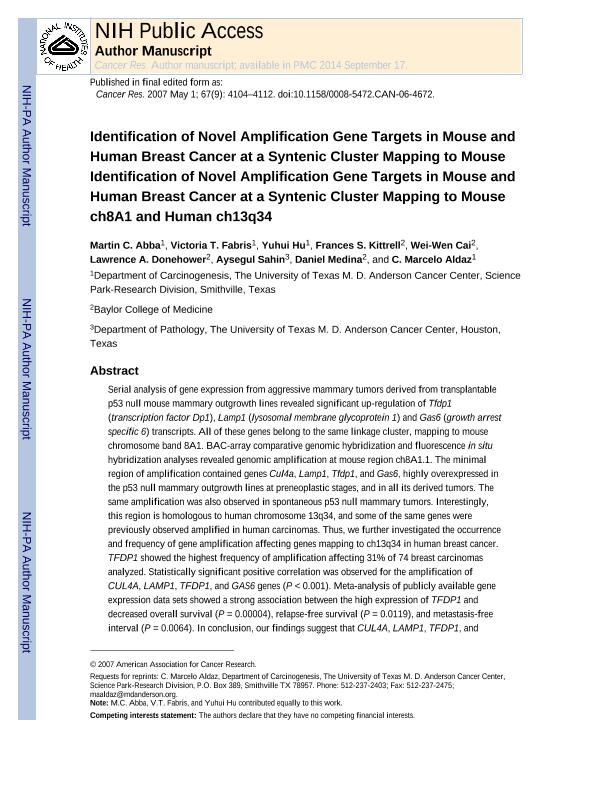Mostrar el registro sencillo del ítem
dc.contributor.author
Abba, Martín Carlos

dc.contributor.author
Fabris, Victoria Teresa

dc.contributor.author
Hu, Yuhui
dc.contributor.author
Kittrell, Frances S.
dc.contributor.author
Cai, Wei Wen
dc.contributor.author
Donehower, Lawrence A.
dc.contributor.author
Sahin, Aysegui
dc.contributor.author
Medina, Daniel
dc.contributor.author
Aldaz, Claudio Marcelo

dc.date.available
2017-11-03T00:21:22Z
dc.date.issued
2007-05-04
dc.identifier.citation
Abba, Martín Carlos; Fabris, Victoria Teresa; Hu, Yuhui; Kittrell, Frances S.; Cai, Wei Wen; et al.; Identification of novel amplification gene targets in mouse and human breast cancer at a syntenic cluster mapping to mouse identification of novel amplification gene targets in mouse and human breast cancer at a syntenic cluster mapping to mouse ch8a1 and human ch13q34; American Association for Cancer Research; Cancer Research; 67; 9; 4-5-2007; 4104-4112
dc.identifier.issn
0008-5472
dc.identifier.uri
http://hdl.handle.net/11336/27515
dc.description.abstract
Serial analysis of gene expression from aggressive mammary tumors derived from transplantable p53 null mouse mammary outgrowth lines revealed significant up-regulation of Tfdp1 (transcription factor Dp1), Lamp1 (lysosomal membrane glycoprotein 1) and Gas6 (growth arrest specific 6) transcripts. All of these genes belong to the same linkage cluster, mapping to mouse chromosome band 8A1. BAC-array comparative genomic hybridization and fluorescence in situ hybridization analyses revealed genomic amplification at mouse region ch8A1.1. The minimal region of amplification contained genes Cul4a, Lamp1, Tfdp1, and Gas6, highly overexpressed in the p53 null mammary outgrowth lines at preneoplastic stages, and in all its derived tumors. The same amplification was also observed in spontaneous p53 null mammary tumors. Interestingly, this region is homologous to human chromosome 13q34, and some of the same genes were previously observed amplified in human carcinomas. Thus, we further investigated the occurrence and frequency of gene amplification affecting genes mapping to ch13q34 in human breast cancer. TFDP1 showed the highest frequency of amplification affecting 31% of 74 breast carcinomas analyzed. Statistically significant positive correlation was observed for the amplification of CUL4A, LAMP1, TFDP1, and GAS6 genes (P < 0.001). Meta-analysis of publicly available gene expression data sets showed a strong association between the high expression of TFDP1 and decreased overall survival (P = 0.00004), relapse-free survival (P = 0.0119), and metastasis-free interval (P = 0.0064). In conclusion, our findings suggest that CUL4A, LAMP1, TFDP1, and GAS6 are targets for overexpression and amplification in breast cancers. Therefore, overexpression of these genes and, in particular, TFDP1 might be of relevance in the development and/or progression in a significant subset of human breast
dc.format
application/pdf
dc.language.iso
eng
dc.publisher
American Association for Cancer Research

dc.rights
info:eu-repo/semantics/openAccess
dc.rights.uri
https://creativecommons.org/licenses/by-nc-sa/2.5/ar/
dc.subject
Mouse
dc.subject
Ch8a1
dc.subject
Human
dc.subject
Ch13q34
dc.subject.classification
Bioquímica y Biología Molecular

dc.subject.classification
Medicina Básica

dc.subject.classification
CIENCIAS MÉDICAS Y DE LA SALUD

dc.title
Identification of novel amplification gene targets in mouse and human breast cancer at a syntenic cluster mapping to mouse identification of novel amplification gene targets in mouse and human breast cancer at a syntenic cluster mapping to mouse ch8a1 and human ch13q34
dc.type
info:eu-repo/semantics/article
dc.type
info:ar-repo/semantics/artículo
dc.type
info:eu-repo/semantics/publishedVersion
dc.date.updated
2017-10-12T19:49:14Z
dc.identifier.eissn
1538-7445
dc.journal.volume
67
dc.journal.number
9
dc.journal.pagination
4104-4112
dc.journal.pais
Estados Unidos

dc.journal.ciudad
Filadelfia
dc.description.fil
Fil: Abba, Martín Carlos. University of Texas; Estados Unidos. Consejo Nacional de Investigaciones Científicas y Técnicas; Argentina
dc.description.fil
Fil: Fabris, Victoria Teresa. University of Texas; Estados Unidos. Consejo Nacional de Investigaciones Científicas y Técnicas. Instituto de Biología y Medicina Experimental. Fundación de Instituto de Biología y Medicina Experimental. Instituto de Biología y Medicina Experimental; Argentina
dc.description.fil
Fil: Hu, Yuhui. University of Texas; Estados Unidos
dc.description.fil
Fil: Kittrell, Frances S.. Baylor College of Medicine; Estados Unidos. University of Texas; Estados Unidos
dc.description.fil
Fil: Cai, Wei Wen. University of Texas; Estados Unidos. Baylor College of Medicine; Estados Unidos
dc.description.fil
Fil: Donehower, Lawrence A.. University of Texas; Estados Unidos
dc.description.fil
Fil: Sahin, Aysegui. University of Texas; Estados Unidos
dc.description.fil
Fil: Medina, Daniel. University of Texas; Estados Unidos. Baylor College of Medicine; Estados Unidos
dc.description.fil
Fil: Aldaz, Claudio Marcelo. University of Texas; Estados Unidos
dc.journal.title
Cancer Research

dc.relation.alternativeid
info:eu-repo/semantics/altIdentifier/url/http://cancerres.aacrjournals.org/content/67/9/4104
dc.relation.alternativeid
info:eu-repo/semantics/altIdentifier/doi/http://dx.doi.org/10.1158/0008-5472.
dc.relation.alternativeid
info:eu-repo/semantics/altIdentifier/pmid/https://www.ncbi.nlm.nih.gov/pmc/articles/PMC4166497/
dc.relation.alternativeid
info:eu-repo/semantics/altIdentifier/pmid/17483321
Archivos asociados
